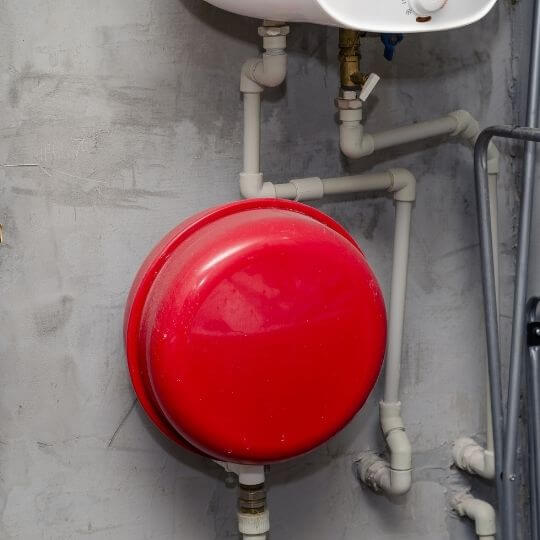Many people, especially those who use a tankless water heater, are unaware of the importance of water heater expansion tanks. Before you can answer the question, “is an expansion tank required for a water heater?” you must first understand what an expansion tank is. You’ll also need to understand the circumstances in which you’ll need to get one.
What is a water heater expansion tank?

A water heater expansion tank is a safety device that protects your plumbing system from pressure damage [1]. It’s also known as a thermal expansion tank. By law, homeowners in most large North American cities are required to install thermal expansion tanks. Whenever the water tank heats up, extra water volume is formed due to the natural expansion of water when heated (a process known as thermal expansion).
According to estimates, a typical 50-gallon water heater tank expands to around 52 gallons when heated to 120 degrees Fahrenheit. This extra water volume creates a rise in pressure, which can damage your water heater, plumbing fixtures, and water pipelines over time if it is managed effectively. This is where the thermal expansion tank comes in.
Purpose of a water heater expansion tank
The extra pressure inside the water heater tank must be released because water expands when heated. In the past, the water tank would release the pressure by draining the excess water back into the municipal water supply. A check valve is used in today’s water mains to prevent backflow and release of pressure in the wrong direction. The check valve keeps wastewater from inside the house from entering the water supply and therefore contaminating it.
A water heater expansion tank refers to a small tank that connects to the water heater’s water supply pipe. The expansion tank prevents excessive water pressure by handling the thermal expansion of water in the heater. Water pressure that is too high can harm plumbing fixtures, supply pipe couplings, and the water heater itself. Therefore, water from the water heater expands and flows into the expansion tank, thereby reducing system water pressure.
What does a thermal expansion tank look like?
The typical domestic expansion tank resembles a tiny propane tank in appearance. Off-white or blue are the most popular colors. It has a Schrader valve on top, similar to the air valve found on most tires. There is a threaded pipe connector on the bottom [4]. They are typically the size of a basketball, depending on the size of the water heater(s) they serve. Below is a water heater expansion tank installation diagram.
How expansion tanks operate

An expansion tank facilitates the longevity of your water heater. Water expands when it heats up. A closed plumbing system without an expansion tank might be damaged by this thermal expansion [5]. When water is heated from 50 to 120 degrees Fahrenheit, the volume increases by about 2%. The water heater tank and the pipelines and fixtures are relieved of pressure by an expansion tank, which offers space for the expanding water.
An expansion tank is essential in closed plumbing systems, where a pressure-limiting valve or backflow valve keeps the expanding water from backing up into the municipal water main. A flexible rubber diaphragm sits inside an expansion tank, dividing it into two sections: one that accepts expansion water as it heats. The other offers an air chamber that becomes somewhat pressured when the diaphragm expands.
The air in the water expansion tank is compressible by nature. Therefore, when water is heated and expands, the extra liquid flows from the heating unit to the expansion tank, thereby compressing the air. Consequently, more space is available for the increased water volume. As a result, water pressure does not rise to dangerous levels, reducing the risk of damage to the tank, fixtures, and pipes. The diaphragm in the air chamber pushes the water back into eh heater once the pressure has reduced.
Is an expansion tank required for a water heater?
You might be asking yourself, is an expansion tank required for a water heater if you have a private well water source? Most well water systems feature a check valve to prevent the water flowing back into the well [6]. For such a system a water heater expansion tank will be necessary.
A heater system that allows hot water to flow freely from the heater tank into the cold water supply pipe and back into the municipal water system is considered an open water heater system. This happens when there are no valves (such as a shut-off valve, check valve, or other devices) to isolate the water supply mains from the household system.
A closed water heater system, on the other hand, does not allow the hot water to expand past the shut-off or check valves into the main water supply pipe. However, a closed system has the disadvantage of trapping hot water, meaning it has nowhere to go when it expands. This raises the pressure into the system and has the potential to cause system damage. This is why most building codes specify installation of an expansion tank. An expansion tank will protect your water heater and keep it from exploding.
What size expansion tank do I need?

Now that you know the answer to the question, “is an expansion tank required for a water heater,” the next step is to determine the appropriate expansion tank size for your system. First, you’ll need to double-check the capacity of your closed water supply system. To accomplish this, you’ll need to consider two things.
- The capacity of your water heater (in gallons). This information can be found on the label of the heater.
- The pressure of the water. It may not even reach 30 psi at times. However, if you use a portable gauge or phone your water provider, you can get an accurate reading.
Most firms include a calculator or chart that will show you the ideal size and model for your water supply system if you wish to buy an expansion tank. You’ll need an expansion tank that’s the correct size for various reasons. For one, if you utilize an undersized unit, the pressure created by the heated water can damage your pipes.
There will be no problem if you choose an expansion tank with a capacity higher than your system. Indeed, larger tanks are recommended, especially if you are unsure which size to choose [9]. Tanks with a higher capacity can accommodate the demands of any closed water system.
What if I don’t have an expansion tank on my water heater?
Because an expansion tank was not necessary until recently, most residences with a check valve on the water main do not have one. Depending on the architecture of the plumbing in the house, this may or may not result in an excessive buildup of pressure.
If you notice that washers in plumbing fixtures are rapidly deteriorating or water is dripping from the water heater’s relief valve, it may be time to install an expansion tank. It might be a low-cost insurance policy against more costly plumbing system damage in your home.
Is an expansion tank required for a water heater?
Yes, it is required.
Water heater installations usually requires a plumbing permit. You will therefore determine whether or not there are any expansion tank restrictions when you apply for the license to install the water heater. If the system does not contain a pressure-limiting or backflow valve that maintains the system closed, an expansion tank is usually not necessary. However, even if an expansion tank is not required by local law, it is good to add one if your system has a limiting valve.
An expansion tank is always advised if you have a ‘closed-loop system’ caused by a check valve or pressure regulating valve on your house’s water supply line. A frequent analogy is that having high water pressure at home is similar to having high blood pressure. It usually has no negative consequences right away. The long-term wear and tear of this increased pressure, on the other hand, can shorten the life of everything in your plumbing system.
Toilet fill valves, supply lines, and solenoid valves found in washing machines, dishwashers, and ice makers are frequently the weakest portions of the system. When subjected to intense water pressure, these fixtures likely to fail prematurely.
If water is delivered to your home by the city water supply at a pressure over 80 psi, an expansion tank by itself will not help. The pressure-regulating valve (PRV) is responsible for this [10]. The thermal expansion tank is used when the pressure in your home is between 40 and 80 psi, and you have a PRV or check valve. It protects a closed-loop system against the continual high pressure fluctuation induced by thermal expansion.
Depending on where you reside, you may be required to install an expansion tank regardless of water pressure to pass plumbing inspections. This includes requirements necessary for installing a new water heater.
For example, in Frisco, Texas, all new homes must include a PRV and an expansion tank. In addition, all water heaters installed or replaced in Little Elm Texas must have an expansion tank. This is because the water meters are equipped with check valves, resulting in a closed-loop system. To be aware of the applicable plumbing codes in your location, you need to check with your city’s plumbing inspector.
If I have several water heaters, do I need more than one expansion tank?
You’ll need a thermal expansion solution that’s big enough for your piping. A 2-gallon expansion tank, for example, can service a 50-gallon water heater. You can have an expansion tank for each heater or a single, larger expansion tank if you have more than one heater on the same or connected system. Check local plumbing code revisions and the expansion tank manufacturer’s specifications to ensure you have the most up-to-date information for your circumstance.
Final thoughts: Is an expansion tank required for a water heater?
An expansion tank is a small tank installed near a water heater. The tank helps lower the heater’s wall pressure, thereby protecting and allowing it to last longer. Expansion tanks usually inexpensive and simple to set up. There is no need to install this component if you use a tankless water heater system. However, if you have a standard heater, you must have an expansion tank installed to protect your system, especially if is a closed loop system.

Michael Davis is a heating & plumbing expert who currently works as independent contractor in SC. He also writes for Plumbertip.
For almost 10 years he worked on various plumbing tasks across South Carolina.



